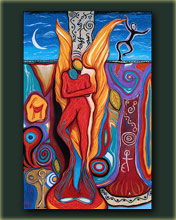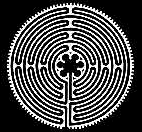Gurdjieff spoke of an inner circle of humanity, a group of conscious men who more or less ran things at the local level in each age.
The idea was not new, but the terms he used to describe it were. He explained to Ouspensky at one point that humanity was divided into three concentric circles: the inner circle of conscious men, the middle circle of men mediating between the two other circles and the outer circle containing most of humanity.
The inner circle of humanity strove to bring the rest of mankind conscious ideas or "C" influences through schools and unbroken chains of transmission. "B" influences also reflect ideas from the Inner Circle but are not delivered through schools. "A" Influences are ideas floating about in life and from life.
Clumsy parodies of this idea have been practiced on a patient world throughout the ages. In the last century, Helena Petrovna Blavatsky kicked off her Theosophical movement with the help of an invisible friend called Hoot Koomi. This spirit acted as a well oiled deus ex machina by delivering letters to her just at the roughest spots in her tumultuous self-invention.
More recently, Claudio Naranjo, one of the inventors of the thriving Enneagram industry, reported that he had personally contacted a member of this inner circle with the aid of a heady cocktail of psychotropic drugs. The spirit so summoned was named Metatron, an appellation which seemed to anticipate a video game action hero.
In the extreme example of this inventive genre, shortly before becoming the Governor of Alabama, an American Evangelist solemnly advised his congregation that his daily wardrobe ensemble was the result of divine dictate, revealed to him in considerable detail by the Almighty Himself.
More seriously, the Gurdjieff notion of an Inner Circle forces us to consider a class of superhumans. While Gurdjieff was strangely reticent about naming names, humanity has widely recognized extraordinary messengers and prophets from beyond the temporal plane for thousands of years. One such cycle of revelation is the Judaic/Christian/Islamic chain.
Taken collectively, the influence of the prophets Abraham, Jesus and Muhammad, (peace be upon all of them), has reverberated down through the last four millennia with a force powerful enough to create and recreate entire civilizations.
Setting aside, for the moment, [the fact that each of them brought a parallel Message according to the Conscious Evolution of humanity during his time], this class of beings possessed qualities far beyond scientific explanation. This all-important factor renders moot arguments among their respective followers about their relative merits. Failure to grasp this point can result in endless hairsplitting.
Religious strife among and within these three groups is generally a sign that the messengers' messages have been lost among the disputants. These three men are so influential that their impacts cannot be separated from our civilization. How could ordinary humans second-guess the lives and missions of beings possessing such sweeping powers and ranges of consciousness? How much do we really understand of their missions? Why were their techniques so remarkably similar? To what extent do they, even now, shape our thoughts?
Much of art, literature and law seem to revolve around the teachings of these men. Millions of lives have been changed by the energy they conducted. And who, if not these, would be the Inner Circle of Humanity? Granted, they are not "hidden," and therefore not as attractive to those who seek the exclusivity of extraterrestrial personal trainers, but there they are, looming large in known history - and with all the right qualifications.
It stands to reason that these leaders have much more in common with each other than we do with them. Do they, in effect, form a special class of beings, conscious men who maintain constant contact with one another while they oversee our spiritual affairs? Such an arrangement would be beyond our poor comprehension.
For those with a penchant for secrecy, Gurdjieff explained that there were naturally evolved people tucked away here and there, separated from schools. Along the same lines, Sufis assert that there are "spiritual poles" in each age (Qutbs), who are often hidden and somehow act as a kind of voltage regulator for the spiritual energies coursing through mankind.
The planet is never without them and they operate largely unnoticed, from incredibly high stations of being.
Subsequent events have revealed the effects of lesser men appropriating the missions of the major Prophets only to deflect the original impetus slightly with each succeeding generation. In any event, from the Gurdjieff perspective, left to its own devices, everything runs down in time. Each great messenger arrives, winds up the mainspring in the clock of human civilization, and then the clock gradually runs down.
Only the intervention of schools of consciousness, operating outside of these general cycles of human history, can rewind the mainspring and preserve some portion of the regenerative aspects of a religion. The great Sufi saints have carefully tended the clock of Islam since its initial winding, revitalizing that faith for each generation, successfully countering the ravages of time against all odds, even into this age.
Gurdjieff contended that, with regard to esoteric schools, the world had long ago been divided up into areas of expertise. Egypt had theory, India had philosophy, and the Middle East had practice. From this perspective, it is not surprising that the three most influential religions of this era were founded by men originating from, (in order of appearance), Chaldea, Israel, and the Arabian Peninsula.
Many of the forty Sufi brotherhoods have traditionally been concentrated in this geographical area specializing in the practical application of mysticism. Such a mission could only have issued from the Middle East according to Gurdjieff's particular information source, whatever it was.
All the Sufi Orders trace their origins directly to the Prophet Muhammad, (peace be upon him). All the orders maintain precise records of lineage leading back to the seventh century of the Common Era.
Each leader of each order has carefully conducted his life in the mold of his prophet. Uniquely positioned for emulation, this Messenger left a surprisingly complete record of his life, practices and sayings. From the Work point of view, the implications of the Sufi phenomena are considerable: these orders strive to emulate practice what is described as the Chain of Transmission. It is more than interesting to see this transmission not as a theoretical postulate - not merely as a blueprint - but as an actual practice.
John Bennet said that the Naqshbandi Sufis seemed to fit the description of a group close to the "Inner Circle." He then appeared to "overhear" himself saying this and went on to wonder, why would such a group be exclusively Islamic? The answer to his question may lie in the placement of Islam in the timeline of human history.
The Sufis insist that the message of Islam was crafted for the modern era, that it caps the succession of messages to the Children of the Book, and that there will be no more messages until the end of this era. Consequently, special care has been taken to maintain life in the tree of Islam, because it's the last tree we're going to get.
In the historical instance of a particular "conscious man" being born to lead his people to a new spiritual plateau, the Prophet Muhammad, (peace be upon him), left in his wake a very detailed tradition about the specific details of his life.
It's not generally known in the West just how much he left behind. His house and certain personal effects still exist in Medina. His sayings (outside of the Quranic revelation, called Hadith) have been carefully recorded in a system that rates the validity of each account. His amazingly tangible history is unique in the cycle of the messengers. His manners and his daily practices virtually form the core of Islamic Law.
The practice of Islam is, in effect, the imitation of the life of a conscious man and the study of the divine revelation he received in the form of the Quran. With varying degrees of success, there are today something over a billion people trying to follow his specific example.
Practice is the key to the Sufi Way. The Quest relies on technique, sincerity, and reinforcement in the person of a guide. Irfaan, the successful transmission and reception of the legacy of the Prophet, (peace be upon him), is a potent and long-lived example of how "C" influences are generated and propagated over the fabric of civilization.
*Note: The Golden Chain of Hadith/Prophetic Tradition has been Passed down from Prophet Muhammad (pbuh) through the 12 Apostles of God ~ The Prototype Of Humanity.
Mysticism : The heartbeat of Islam
What is faith according to Islam? Faith is belief in : One God : A Divine Presence, In the existence of spiritual beings known as angels In the revelations of God, the Psalms revealed to David, the Torah sent down to Moses, the New Testament brought to Jesus and the Final Testament, The living Qur'an brought to Muhammad all the prophets that were sent as mercy to mankind : The Judgement Day and Resurrection The Divine Decree destiny



